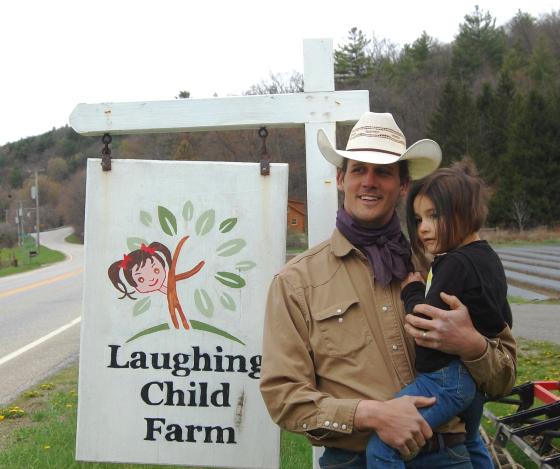Posted March 17, 2022 at 10:36am by Anonymous (not verified)
Sweet potatoes a viable farm business in Vermont

Written by Lindsay Quella
Tim and Brooke Hughes-Muse, owners of Laughing Child Farm in Pawlet, knew they had great idea for their farm when they enrolled in the Vermont Housing and Conservation Board (VHCB) Farm & Forest Viability Program, but weren't so sure about its feasibility. “When we came across sweet potatoes, we thought it could work," recalled Tim, "but we weren’t really sure about the business part of it. So we looked for outside help. That's when we got in touch with VHCB.” The business planning process “really helped us figure out how make decisions that have long-term payoffs. We kind of knew the day-to-day decision making, but where to invest money, that was probably the most valuable part of things for us,” he explained.
While enrolled in VHCB’s Vermont Farm & Forest Viability Program, Tim and Brooke received business planning assistance from Intervale Center’s Sam Smith. Goal 19 of the Farm-to-Plate Strategic Plan says that business planning and technical assistance services will be highly coordinated, strategic, and accessible to Vermont’s food system businesses. The Viability Program’s tight-knit statewide network of independent consultants and service providing organizations for the farm, food and forest products sectors represents significant progress on this particular part of Vermont’s food system plan.
Once the business plan was complete, “we knew we needed to expand our business and scale up because a large part of our business plan was to capitalize on efficiencies,” said Tim. “We identified early on that we needed a storage facility, partly because of the food safety regulations but also because of the working conditions. The storage conditions were just not ideal. It was also very inefficient in terms of our time. That was a barrier for us to expand.”
So Tim and Brooke applied for a Business Plan Implementation Grant through the Viability Program and were awarded funds for their project in spring 2015. “We used the money to build a new storage facility that can hold quite a bit more [product], but also has controlled environmental conditions; it also has proper food safety equipment,” said Tim. “It’s got great lighting and heating [and] an internet connection for systems monitoring.”
One of the biggest changes at Laughing Child Farm since building the storage facility has been a 400% increase in processing efficiency. “[The barn] decreased our handling time of bins," says Tim. "We were processing 1,000 lbs of sweet potatoes [in about] three hours in our old barn. In our new barn we got it down to about 45 minutes. Now that our business is so much larger, we’re still spending the same amount of time washing, but we’re getting a lot more done.” This increase in Laughing Child Farm’s production is a positive step toward meeting Farm-to-Plate Goal 7: Local food production—and sales of local food—for all types of markets will increase. The farm also received technical support from Chris Callahan at UVM Extension in designing the facility, a $20,000 grant from the Working Lands Enterprise Initiative, and additional financing to make the project a reality.
Having developed this product storage expansion project in part as an outgrowth of their business planning work with their Viability Program advisor, Sam Smith, Tim and Brooke are finding that it has benefits that will come in handy down the line. “The barn has really been a central piece to our quality of life, but also for the future development of the business,” said Tim. “It has checked off a couple key items in our business plan. We built it with GAP (Good Agricultural Practices) certification in mind. We’re going for GAP certification in the fall, and that will open up access to supermarket chains and markets we haven’t had access to in the past.”
The increased space and efficiency has also allowed them to consider new partnerships. “We’re thinking about ways to do cooperative growing," said Tim. "Now that we’re able to process so much faster, can we grow more? Or, can we get other people to contract with us?” The advances that Laughing Child Farm has made by way of its Viability Program business planning and implementation projects have opened new opportunities and positioned the business to push the state forward on Farm-to-Plate Goal 12: A sufficient supply of all scales and types of on-farm and commercial storage, aggregation, telecommunications, and distribution services will be available to meet the needs of increasing year-round food production and consumer demand.
Now that processing and storage are taken care of, Tim and Brooke have time to focus on other parts of their business. Tim states, “The next part we have to focus on is harvesting. It’s a long and hard process. [The completion of the storage project] freed us up to think about that more. It’s also given us the tools to figure out how to approach those hurdles.”
The Vermont Farm & Forest Viability Program offers one-on-one, in-depth business planning, technical assistance and management coaching to Vermont farm, food and forestry enterprises in order to improve the economic viability of Vermont's working landscape.
